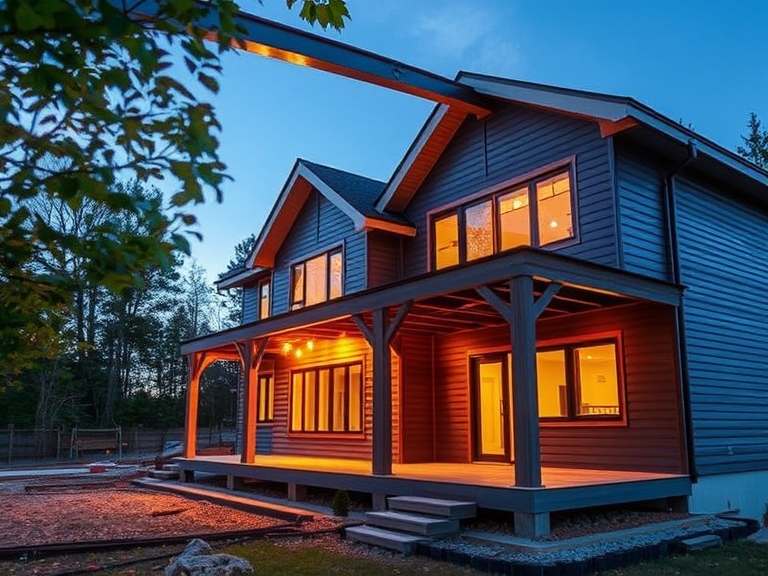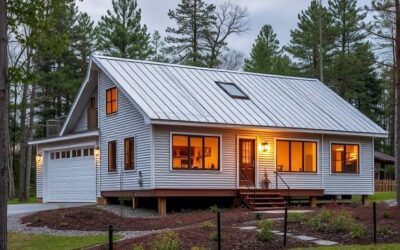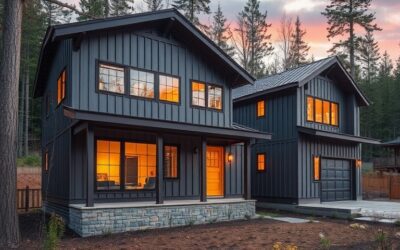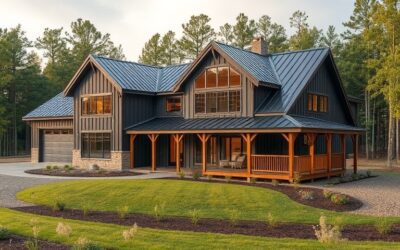Choosing a steel home is a smart way to boost your home’s energy efficiency. Steel homes are known for their durability and flexibility, but they also offer many benefits when it comes to saving energy. These homes are designed to keep your living space comfortable while reducing your energy bills. By understanding how steel homes contribute to energy efficiency, you can make a well-informed decision for your future home.
One of the key factors in the energy efficiency of steel homes is their impressive thermal properties. These properties help maintain a stable indoor temperature, reducing the need for continuous heating or cooling. Additionally, advanced insulation techniques specifically tailored for steel homes further boost their energy-saving capabilities. This means you spend less on energy while enjoying a cozy living environment.
Steel homes also integrate a variety of energy-efficient features that enhance their overall performance. From energy-efficient windows to modern heating and cooling systems, these features work together to minimize energy use. Over time, the benefits of energy efficiency add up, resulting in significant long-term cost savings. Embracing a steel home means investing in a sustainable, energy-saving living space that benefits both you and the environment.
The Thermal Properties of Steel
Steel’s unique thermal properties make it an excellent choice for energy-efficient homes. Unlike wood or brick, steel has a high thermal conductivity, which can be a great advantage when properly managed. This means that steel can transfer heat efficiently, keeping your home warm in the winter and cool in the summer. The key to harnessing these thermal properties lies in how we construct and insulate steel homes, ensuring energy is neither wasted nor excessive.
One crucial aspect is the use of thermal breaks in steel construction. A thermal break is a layer of insulating material placed between sections of steel to prevent thermal bridging, where heat or cold transfers too easily between the outside and inside of the home. By including these breaks, steel homes can maintain a consistent temperature, reducing the need for constant heating or cooling. This feature is especially beneficial in regions with extreme temperature fluctuations.
Additionally, the reflective properties of steel can be utilized to manage solar heat gain. When used in roofing and exterior finishes, steel can reflect a significant portion of solar radiation, preventing excess heat from entering the home. This reduces the workload on air conditioning systems, leading to lower energy consumption and more comfortable indoor temperatures during hot summer months.
Advanced Insulation Techniques for Steel Homes
Advanced insulation techniques are key to maximizing the energy efficiency of steel homes. Proper insulation helps to retain the desired temperature inside the home, minimizing the need for heating or cooling systems. One effective method is the use of spray foam insulation, which can be applied to the walls and roof of a steel home. Spray foam fills gaps and seals cracks, providing an airtight barrier that prevents heat loss in winter and heat gain in summer.
Another effective insulation technique is the use of rigid foam insulation boards. These boards can be installed on the exterior or interior of the steel framing, acting as a continuous insulation layer that further reduces thermal bridging. Rigid foam insulation is highly durable and effective in creating a thermal envelope around the home, ensuring minimal energy loss.
Additionally, incorporating high-performance insulation materials, such as fiberglass or mineral wool, can further enhance the energy efficiency of steel homes. These materials have excellent thermal resistance properties, trapping heat within their fibers and slowing down the transfer of heat through walls and roofs. By combining these advanced insulation techniques, steel homes can achieve superior energy performance, leading to lower utility bills and a more comfortable living environment.
Integrating Energy-Efficient Features
Adding energy-efficient features to steel homes further reduces energy consumption and cuts costs. One critical feature is the use of energy-efficient windows. These windows typically have multiple panes of glass, with gas fillings and special coatings that minimize heat transfer. Installing energy-efficient windows helps to keep the indoor temperature stable by preventing heat loss in winter and heat gain in summer.
Another important feature is the use of modern heating, ventilation, and air conditioning (HVAC) systems that are designed to work efficiently. These systems can be programmed to operate at optimal levels, providing just the right amount of heating or cooling based on the specific needs of the home. Smart thermostats can also be integrated to learn your heating and cooling preferences, adjusting automatically to save energy without sacrificing comfort.
In addition, using energy-efficient lighting and appliances can significantly impact your home’s energy consumption. LED lights, for example, use much less electricity than traditional incandescent bulbs and can last significantly longer. Energy Star-rated appliances are designed to use less energy during operation and can drastically reduce your electricity usage over time. By incorporating these energy-efficient features, a steel home can become an exemplary model of energy conservation and sustainability.
Long-Term Cost Benefits of Energy Efficiency
The long-term savings from energy efficiency in steel homes are substantial. By reducing energy consumption, you lower your monthly utility bills, resulting in significant savings over the years. The initial investment in energy-efficient features and advanced insulation may seem high, but the return on investment is quickly realized through reduced energy costs.
Another cost benefit comes from the longevity and durability of steel homes. With less need for repairs and maintenance compared to traditional homes, you save money on upkeep. Energy-efficient homes also tend to have higher resale values because future buyers recognize the savings and sustainability benefits. When you decide to sell, your energy-efficient steel home becomes an attractive option for environmentally conscious buyers looking to save on their energy bills.
Furthermore, living in an energy-efficient home can qualify you for various incentives, rebates, and tax credits offered by government programs. These financial incentives are designed to encourage homeowners to adopt energy-saving measures, making the transition to an energy-efficient steel home even more affordable. Overall, the long-term cost benefits of choosing a steel home that prioritizes energy efficiency are significant, providing both immediate and future financial advantages.
Conclusion
Steel homes offer an unbeatable mix of durability, flexibility, and energy efficiency. By understanding the thermal properties of steel and utilizing advanced insulation techniques, we can create homes that maintain comfortable indoor temperatures while reducing energy consumption. Additionally, integrating energy-efficient features such as windows, HVAC systems, and lighting ensures that these homes are not only environmentally friendly but also economically beneficial.
The long-term cost benefits of an energy-efficient steel home are compelling, from lower utility bills to higher resale values and potential financial incentives. Investing in a steel home means making a sustainable choice that supports both your wallet and the environment. The durability and low maintenance needs of steel further contribute to its appeal, ensuring your home remains efficient and robust for many years.
Ready to explore the energy efficiency of steel homes further? Contact Wink Panels LLC to learn more about how we can help you build an energy-efficient, sustainable living space tailored to your needs. Let’s work together to create the home of your dreams while saving energy and money.




